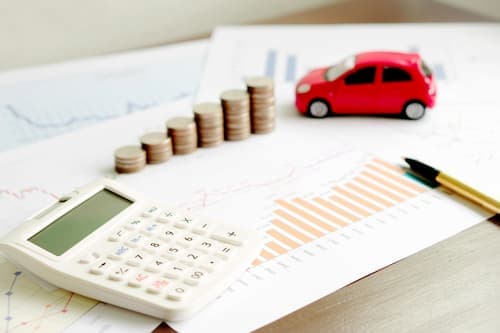- What is a car insurance deductible?
- How does a car insurance deductible work?
- When do you pay the deductible for car insurance?
- How your deductible affects auto insurance
- High deductible vs. low deductible auto insurance
- How much will raising my deductible save me?
- Car insurance deductibles and claim costs
- What happens if you can't pay your car insurance deductible?
- FAQ: Car insurance deductibles
What is a car insurance deductible?
A car insurance deductible is the amount you must pay when filing a comprehensive or collision insurance claim with your insurer. It will be deducted from the claim settlement.
You choose your deductible amount when you buy an auto insurance policy, but you can change it anytime.
Deductibles allow the insurance company to price your policy based on the financial risk you are willing to take on yourself. People with higher deductibles are less likely to file claims, since the threshold for a payout is higher. As a result, insurance companies charge them less.
How does a car insurance deductible work?
When you file a claim for which a deductible applies, the insurance company will deduct that amount from your payout.
For instance, if a tree falls on your car, causing $1,000 in damage, you don't get a $1,000 check from your insurer. You get $1,000 minus your deductible. If your policy has a $250 deductible, your insurer pays you $750. If your deductible is $500, you’ll get $500. And if your deductible is $1,000, the insurer would not pay at all.
As you can see, the deductible determines whether it’s worth filing a claim.
When do you pay the deductible for car insurance?
You pay the deductible whenever you file a claim for which a deductible is listed on your policy. For most people, that’s comprehensive or collision insurance.
Sometimes, you may also pay a deductible for personal injury protection coverage or uninsured/underinsured motorist coverage.
When your car is repaired, you will pay your portion of the damage, which is the deductible. You don’t have to pay it to the insurance company; instead, it will be deducted from the settlement check. You’ll pay that portion to the repair shop.
Some repair shops will not begin work until you have paid the deductible; ask when you should pay it.
How your deductible affects auto insurance
Your deductible directly affects what you pay for car insurance. A higher deductible means you will pay less in premiums. A lower deductible has the opposite effect, increasing your premiums.
Because the deductible is your portion of the financial risk of a claim, insurance companies charge you less when you choose to take on more of that risk with a higher deductible.
Of course, that means you need to have that money available to pay if your car is damaged. You can think of choosing a lower deductible as paying that amount to the insurance company in advance, so it will pay more if there’s a claim. However, you don’t get that money back if you don't file a claim. By saving that money, you keep it in your pocket and give less money to the insurance company.
High deductible vs. low deductible auto insurance
When selecting your deductible, consider the following factors:
- What can you afford to pay if your car is damaged? If you have one car and you need it to commute to work, you probably don't want a deductible that exceeds your savings.
- How much would filing a smaller claim affect your future premiums? A low deductible may not benefit you, because filing a claim for a low amount could raise your future premiums by more than you may collect.
- How much can you save by raising your deductible, and how many years would it take for the premium savings to offset the extra cost if you file a claim?
Remember that adjusting your deductible amount is just one way to get cheap car insurance. If you're looking to get lower rates, look at all ways you can save.
How much will raising my deductible save me?
Here’s a look at average premiums with deductibles for comprehensive and collision ranging from $250 to $2,500. Going from the lowest to the highest deductible saves $1,271 a year on average, while you can save $323 a year on average by bumping your deductibles from $500 to $1,000.
| Deductible | Average annual premium |
|---|---|
| $250 | $3,713 |
| $500 | $3,300 |
| $1,000 | $2,977 |
| $1,500 | $2,730 |
| $2,000 | $2,570 |
| $2,500 | $2,442 |
However, how much you will actually save depends on many factors, including your insurance company, driving record, and where you live.
Insurance premiums at different deductible amounts
Below, you can compare how rates are affected by the deductible for major carriers in each state. Select your state to see how much you could save, on average.
USAA $2,132 $178 State Farm $2,533 $211 GEICO $3,716 $310 Progressive $3,849 $321 Farmers $6,279 $523 Allstate $6,992 $583
A car insurance rate comparison tool can help you easily evaluate quotes from competing insurers and show you the best deal at whatever deductible you choose.
Car insurance deductibles and claim costs
Having a lower deductible means you can file a smaller claim, but that doesn’t mean it’s a sound financial decision in the long run. Let’s explain with the hypothetical example of a driver we’ll call Trey.
Trey chooses $250 deductibles for comprehensive and collision. He pays an insurance rate of $110 a month for full coverage on his car.
Backing out of his garage, Trey’s car hits a light pole, doing $850 worth of damage. With a $250 deductible, Trey’s insurance will pay $500 for the repairs, so he files a claim.
Trey loses his claim-free discount and is also surcharged for an at-fault accident. On renewal, his rate goes up to $155 a month. Over the next year, Trey pays $540 more for insurance, more than his insurer had paid for the claim. If the higher rate lasts three years, Trey will have paid $1,620 more for insurance.
Over the next three years, Trey pays $1,860 a year for his insurance totalling $5,580. With the $250 deductible he paid for the accident, his three-year cost is $5,380.
Let’s consider the same situation with a $1,000 deductible, where Trey’s monthly rate is $75. When the fender bender happens, it’s below his deductible, so he covers the $850 out of pocket. He keeps his claim-free discount and isn’t charged for an accident, so his monthly rate stays at $75.
Over the next three years, Trey pays $900 a year for car insurance for a total of $2,700 over three years. Adding the $850 he paid to fix his car, his total is $3,350 over three years.
That means that Trey will have saved a total of $2,030 over three years by carrying a higher deductible and paying for minor damage himself.
If the car is being repaired, you'll need to pay the deductible amount to the repair shop for the work to be completed.
What happens if you can't pay your car insurance deductible?
If you can't pay your deductible, you have a few options:
- Delaying repairs. You can put off the repair until you have the money if you have alternate transportation or your car is safe to drive. Keep in mind, though, that you still need to report the claim immediately for your insurer to pay it.
- Shop for lower-cost repairs. If the check is made out to you, try searching for a few more estimates to see if you can find a cheaper repair cost. Some shops will "waive" the deductible, which means they'll perform the work for less than the estimated cost or the adjuster's numbers.
- Search for a car insurance deductible payment plan. Ask your preferred shop about a car insurance deductible payment plan, allowing you to pay your part of the bill over time. You'll probably have to pay interest, but your car can be repaired promptly.
Car insurance deductible amounts are a personal consideration. The right one for you depends on your driving record, location, financial position, insurer and other factors. Compare quotes from multiple insurance companies at multiple deductible levels to find the best price with a deductible you can afford.
FAQ: Car insurance deductibles
Do you have to pay your deductible if you're not at fault?
You may have to pay your deductible even if you’re not at fault. If you file a claim against your own policy for collision or comprehensive coverageComprehensive coverage helps pay for damage to your car caused by events other than a collision, such as theft, fire, vandalism, or natural disasters. It is subject to a deductible., you will pay the deductible. If possible, your insurer will subrogate to recoup that cost from the at-fault driver’s insurance company.
Is it better to have a high or low deductible for car insurance?
The right deductible depends on your budget. While a high deductible means lower payments, it also means higher out-of-pocket costs if you have to file a claim. Find the balance between monthly costs and claim costs that works for you.



